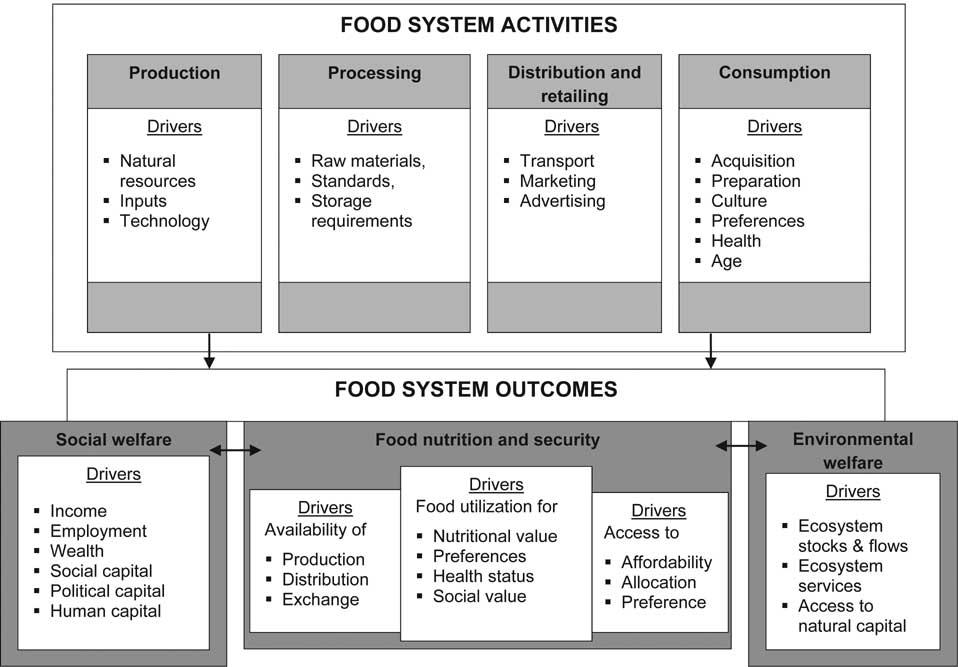
| Previous | Return to table of contents | Search Reports | Next |
| « Back to weltagrarbericht.de | ||
108 | IAASTD Global Report

(Figure 2-5. Food system activities and outcomes. Source: Adapted from GECAFS, 2008.
|
the Middle East, and in Western Europe (Welch and Graham, 1999; Stringer, 2000; Knudsen et al., 2005). Technology advancements and domestic food and agricultural production policies allowed consumers to spend a smaller portion of their income on food by the end of the 20th century (Johnson, 2000; Khush, 2001) allowed consumers to spend a smaller portion of their income on food (Knudsen et al., 2005). Institutional factors like efficient marketing systems, dynamic production technology and higher education played equally important roles in generating longterm growth in agricultural output per hectare and person employed (Mellor, 1966; Hayami and Ruttan, 1985; Eicher and Staatz, 1998). Food processing and preservation involving new technologies such as cold storage; irradiation; high temperature treatments; chemical additives; canning; milling, labeling and sophisticated computer based controlled systems emerged, both creating and taking advantage of new mass markets. The advantages of pre-prepared timesaving food to rapidly urbanizing populations drove further innovations in food preservation. In OECD countries, a few international food processing giants controlled a wide range of well-known food brands, coexisting with a wide array of small local or national food processing companies. Globalized food trade was originally confined to commodities and non-perishables such as wine, salt, spices and dried fish but expanded to include a wide range of perishable foods transported, sold and consumed at long distances away from their production and processing locality (Young, 2004; Knudsen et al., 2005). Even consumers in rural areas became less dependent on food supplies from local farms and markets (Roth, 1999). Meanwhile, small food retail groceries merged or were swallowed by other emerging and increasingly powerful stores, chains and supermarkets (Smith and Sparks, 1993; Roth, 1999). In the USA for example, from 1990-2000, the market share of the meat industry held by |
the nation's top four retailers rose from 17 to 34%. Institutional linkages within local food systems (Lyson, 2005) were thus broken and economies of scale increased by means of new institutional arrangements (Ericksen, 2006ab). Vertical integration in ownership of food supply chains (FAO, 2005c) and increasing concentration in private sector control over food systems (DFID, 2005) has been documented. 2.3.3.3 Food systems outcome trends The globalized food system (GFS) is considered by some to be economically efficient and productive (Welch and Graham, 1999; LaBelle, 2005) and draws on a range of science, knowledge and technology that extends beyond the agricultural sector. The GFS however hides disparities among agricultural and food systems both in developed and developing countries (Knudsen et al., 2005; LaBelle, 2005). Concerns revolve around social welfare; food and nutritional security; food sovereignty, food safety and environmental welfare (Knudsen et al., 2005; Lyson, 2005) (Figure 2-6). Social welfare. The GFS widened the gap between the most productive and least productive systems: it increased 20-fold over the last 50 years, particularly between industrialized and developing countries1 (Knudsen et al., 2005; Mazoyer, 2005). Characterized by capital intensive AKST and seed/ animal breeds that required high inputs and favorable agronomic conditions, the GFS favored farming populations with more resources (Knudsen et al., 2005; Lyson, 2005). There is some evidence that the Green Revolution, e.g., in 1 With the exception of some portions of Latin America, North Africa, South Africa and Asia where it has been adopted by large national or foreign farms that have the necessary capital (Knudsen et al., 2005). Africa has the lowest production per unit area of land in the world (Paarlberg, 2002). |
| Previous | Return to table of contents | Search Reports | Next |
| « Back to weltagrarbericht.de | ||